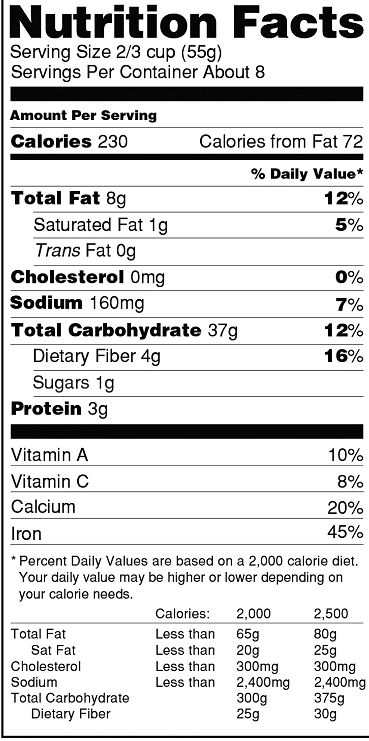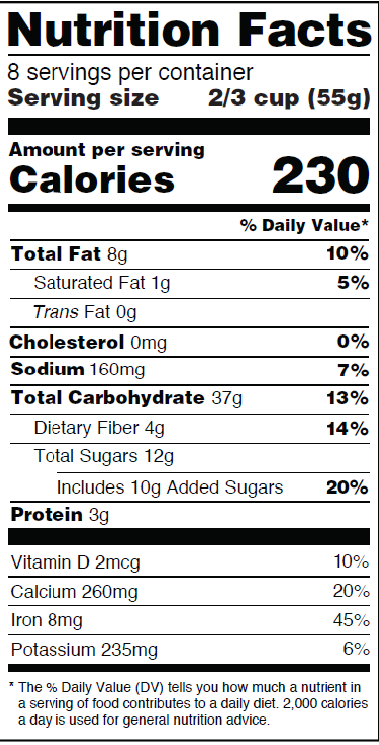You may have noticed it already. Brands have started to push out packaging that looks familiar except for one thing: The nutrition facts panel has been made over. Same goes for your vitamins and supplements. Manufacturers were asked to update labels in ways that would help consumers make more informed choices. While this will take a while to roll out completely, you can get ahead of the game now. Here’s a rundown of what’s new, what changed and what this means for your health.
Hi, I’m Sam Kramer, Vitacost Registered Dietitian and host of Nutrition Bites.
For your health – and the health of your family – it’s important to know exactly what you’re putting in your body. To fully understand the foods and supplements you consume, you have to be able to read the facts label. There are two different facts labels. Nutrition Facts are found on food products, while the Supplement Facts label is found on, of course, supplement bottles. They inherently promote the same information but have different regulations set by the Food and Drug Administration (FDA).
Let’s start with a Nutrition Facts label.

At the top you have Serving Size. This is the amount that is typically eaten in one serving and dictates the values of calories (or energy), macronutrients and micronutrients. Common serving sizes include cups, ounces, an entire package or individual items (e.g. piece, slice, muffin, etc.).
Be mindful of the Servings Per Container. If there is only one Serving Per Container, the listed nutrient values are what you get for the entire container. However, if there are two servings per container and you consume the entire container, you must double the listed nutrient values. You can see how easy it is to lose track of how much you’re actually eating. That’s why it’s so important to not eat directly from the package and serve things on a plate, instead. You’ll perfect portion control and prevent overconsumption.
Below the Serving Size is the amount of calories, or the amount of energy, that’s in the food. Each person’s needs vary, but always consider the nutritional value of the food. Is it just energy dense (loads of calories) or does it provide other nutrients? This is an important distinction when it comes to properly fueling your body.
Under Calories are the macronutrients: Total Fat, Total Carbohydrate and Protein. Total Calories comes from these macronutrients. Total Carbohydrates and Protein are calculated as 4 calories per gram and Total Fat is based on 9 calories per gram. You can multiply these respective numbers by the amount of grams to obtain the proportion of each macronutrient in Calories. For instance, if a food has 6 grams of protein, you would multiply 4 calories by 6 grams to get a total of 24 calories. So of the total number of calories, 24 come from protein.
You may also notice the breakout of the macronutrients into their subcomponents. For example, some products list Monounsaturated and Polyunsaturated Fat or Soluble Fiber.
You may also notice the % Daily Value (%DV) on the right-hand side. These percentages are based on a 2,000-calorie diet. If your diet is more or less than 2,000 calories per day, the percentages on the package would not directly relate to your needs.
Below the line is a list of four key micronutrients. In sufficient quantities, these nutrients have shown to help sustain body function and reduce the risk of disease.
That covers the basics for of the Nutrition Facts label. As promised, though, there are changes on the horizon. These changes are required to be in effect by 2020.

Take a look at the new Nutrition Facts label, which you may have already noticed on some products. You can see that it presents the same information with a few modifications.
Some of these changes are apparent from looking at it, such as the more prominent labeling of Calories, bolder and larger display of Serving Size and Servings Per Container. You may have also noted the addition of Added Sugars; this is now a required subcomponent.
Some not-so-apparent updates include changes to the %DVs and more realistic serving size ranges. You’ll also see a change to two micronutrients. The FDA has suggested removing Vitamins A and C and replacing them with Vitamin D and Potassium. The four micronutrients you will see on the new label are Vitamin D, Calcium, Iron and Potassium, along with their respective amounts and percentages.
As mentioned earlier, the Nutrition Facts label isn’t the only one getting a makeover. The Supplement Facts label has changed, as well. It promotes the same nutrition data but with a focus on micronutrients and dietary ingredients, as seen below.

Here’s a quick synopsis of the updated guidelines and how they differ between the new Supplement Facts panel and Nutrition Facts label:
- You must list dietary ingredients without RDIs or DRVs in the Supplement Facts panel for Dietary Supplements. You are not permitted to list these ingredients in the Nutrition Facts panel for foods.
- You may list the source of a dietary ingredient in the Supplement Facts panel for dietary supplements. You cannot list the source of a dietary ingredient in the Nutrition Facts panel for foods.
- You are not required to list the source of a dietary ingredient in the Ingredient statement for dietary supplements if it is listed in the Supplement Facts panel.
- You must include the part of the plant from which a dietary ingredient is derived in the Supplement Facts panel for dietary supplements. You are not permitted to list the part of a plant in the Nutrition Facts panel for foods.
- You are not permitted to list zero amounts of nutrients in the Supplement Facts panel for dietary supplements. However, you are generally required to list zero amounts of nutrients in the Nutrition Facts panel for food.
For more information, watch the full Nutrition Bites episode above. If you have questions, feel free to leave them in the comments section below or on the Vitacost Facebook page.
